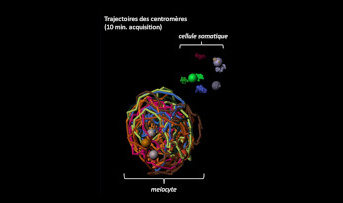Admiring the ballet of chromosomes during meiosis in real-time
plants reproduction
recombination
meiosis
Publication from the MeioMe team, in Nature Communications, July 2024
Sexual reproduction is a major source of genetic diversity. In all species, whether animal or plant, this reproduction relies on the alternation of phases where parental chromosomes come together (fertilization, the fusion of two parental gametes) and separate (meiosis, the formation of gametes). For the separation of chromosomes during meiosis to be balanced, it is essential that homologous chromosomes recognize each other and associate in what are called bivalents. Any disruption of this bivalent formation can lead to severe fertility issues in the parents or chromosomal abnormalities in the offspring. How parental chromosomes recognize each other in a crowded nuclear space filled with non-homologous chromosomes, and how they associate without causing problematic entanglements, remains a great mystery.
Through the study of chromosome dynamics in living cells, the IJPB MeioMe, MiN & epiARN has discovered that in the model plant Arabidopsis thaliana, chromosomes, during this phase of searching and pairing, exhibit extremely rapid movements, as if they were being violently shaken in the nuclear space. This study not only revealed these movements in plants but also enabled their quantitative analysis. Chromosomes can travel up to 50 times their length in an hour, which is 2 mm! By testing the impact of mutations affecting various aspects of the cellular machinery (recombination, chromosome structure, nuclear envelope components), the scientists discovered that chromosome movements primarily depend on the attachment of chromosomes by their ends (telomeres) to the nuclear envelope.
These results demonstrate the conservation of these meiotic chromosomal movements in plants and establish A. thaliana as a new model species for their functional study. We will now be able to analyze in detail the mechanisms and function of this particular chromosomal dynamics. We hope to answer the following questions: How do chromosomes find their partner? What are the impacts on fertility when these chromosomal movements are suppressed? And finally, what roles do these movements play in meiotic recombination?
Research developed at the Institute Jean-Pierre Bourgin for Plant Sciences.
Through the study of chromosome dynamics in living cells, the IJPB MeioMe, MiN & epiARN has discovered that in the model plant Arabidopsis thaliana, chromosomes, during this phase of searching and pairing, exhibit extremely rapid movements, as if they were being violently shaken in the nuclear space. This study not only revealed these movements in plants but also enabled their quantitative analysis. Chromosomes can travel up to 50 times their length in an hour, which is 2 mm! By testing the impact of mutations affecting various aspects of the cellular machinery (recombination, chromosome structure, nuclear envelope components), the scientists discovered that chromosome movements primarily depend on the attachment of chromosomes by their ends (telomeres) to the nuclear envelope.
These results demonstrate the conservation of these meiotic chromosomal movements in plants and establish A. thaliana as a new model species for their functional study. We will now be able to analyze in detail the mechanisms and function of this particular chromosomal dynamics. We hope to answer the following questions: How do chromosomes find their partner? What are the impacts on fertility when these chromosomal movements are suppressed? And finally, what roles do these movements play in meiotic recombination?
Research developed at the Institute Jean-Pierre Bourgin for Plant Sciences.
Back

Legend: Comparison of the trajectories achieved by centromeres from a somatic cell or a meiocyte from the same tissue (male reproductive tissue) during 10 minutes of acquisition.
Highlight IJPB
Référence:
L Cromer, M Tiscareno-Andrade, S Lefranc, A Chambon, A Hurel, M Brogniez, J Guérin, I Le Masson, G Adam, D Charif, P Andrey & M Grelon (2024) Rapid meiotic prophase chromosome movements in Arabidopsis thaliana are linked to essential reorganization at the nuclear envelope, Nature Communications
doi: https://doi.org/10.1038/s41467-024-50169-4
Contact :
Mathilde Grelon, contact
IJPB Teams:
"Meiosis Mechanisms" MeioMe
"Modeling and Digital Imaging" MiN
"Epigenetics and small RNAs" epiARN
"Bioinformatics and informatics" SC-Info